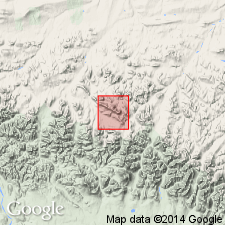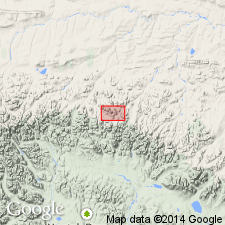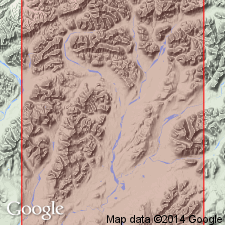
- Usage in publication:
-
- Nuka Formation*
- Modifications:
-
- Named
- Biostratigraphic dating
- Dominant lithology:
-
- Arkose
- Limestone
- Shale
- Chert
- AAPG geologic province:
-
- Alaska Northern region
Summary:
Named after Nuka River. Type section (in part) designated across nose of Nuka Ridge syncline between 68 deg 38'00"N, 159 deg 15'15"W and 68 deg 36'30"N, 159 deg 12'W, Brooks Range, northern AK. Sections also exposed on west side of Singayoak Creek Gap and in cutbanks 2 mi southwest of Nuka Ridge syncline. Occurs in 170-mi-long band along northern front of Brooks Range. Initially these rocks were thought to be facies of Lisburne Limestone (now Group). Consists of succession of fine clastic, feldspathic coarse clastic and cherty strata. Divided into 13 members characterized by light-colored arkosic to calcarenite layers, by dark-colored layers of mud shale to calcilutite, or by varicolored chert and cherty shale. Is more than 7600 ft thick. Base not exposed; may overlie Lisburne Group. Disconformably underlies Jurassic(?) graywacke. Age is Late Mississippian to Late Permian based on marine fossils identified by J.T. Dutro, Jr.
Source: GNU records (USGS DDS-6; Menlo GNULEX).

- Usage in publication:
-
- Nuka Formation*
- Modifications:
-
- Age modified
- Biostratigraphic dating
- Reference
- AAPG geologic province:
-
- Alaska Northern region
Summary:
Type section is restudied and found not to be a single stratigraphic sequence. Section within type is designated a reference section restricted to middle coarse-grained arkosic rocks of old section. Columnar sections show unconformities and repetition of strata. On basis of identifiable fossils, Nuka Formation is now considered to be Late Mississippian and Permian in age.
Source: GNU records (USGS DDS-6; Menlo GNULEX).

- Usage in publication:
-
- Nuka Formation*
- Modifications:
-
- Age modified
- Biostratigraphic dating
- AAPG geologic province:
-
- Alaska Northern region
Summary:
Mississippian foraminifers and conodonts occur in Nuka Formation from wide area in western Brooks Range. Recent collections of conodonts from upper beds of Nuka Formation indicate unit is not older than Early Pennsylvanian (A.G. Harris, written commun., 1982). Age therefore is considered to be Late Mississippian and Early Pennsylvanian(?). Base of unit is gradational into Kayak Shale.
Source: GNU records (USGS DDS-6; Menlo GNULEX).
For more information, please contact Nancy Stamm, Geologic Names Committee Secretary.
Asterisk (*) indicates published by U.S. Geological Survey authors.
"No current usage" (†) implies that a name has been abandoned or has fallen into disuse. Former usage and, if known, replacement name given in parentheses ( ).
Slash (/) indicates name conflicts with nomenclatural guidelines (CSN, 1933; ACSN, 1961, 1970; NACSN, 1983, 2005, 2021). May be explained within brackets ([ ]).

